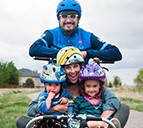This story on Earth Day is the first in our six-week series on sustainability and healthy, happy living.
The 50th anniversary of Earth Day is just around the corner (it’s happening in 2020), but how did Earth Day begin? The event is born from the Civil Rights movement. Inspired by widespread anti-war protests of the late 1960s and rising from the wake of a catastrophic oil spill in California, the first Earth Day took place on April 22, 1970.
At inception, Earth Day was a unifying celebration bringing together people from diverse communities, as well as from differing political alignments, who were no longer willing to accept air pollution as the new norm. With 20 million participants, the first Earth Day led to formation of the Earth Day Network, the U.S. Environmental Protection Agency, and passage of critical Clean Air and Clean Water Acts. By 1990, Earth Day became a global movement with more than 200 million people helping to elevate environmental awareness.
Earth Day 2017 is themed for Environmental and Climate Literacy, in pursuit of a “global citizenry fluent in the concepts of climate change.” Thus, Earth Day Network has joined forces with The March for Science to revive a teach-in concept employed during the very first Earth Day. The teach-ins raise awareness about the role that science plays in all of our lives, specifically by preserving the environment. This year, March for Science events will take place in cities across the country on April 22. If a massive gathering isn’t for you, there are plenty of other opportunities to partake in.
Earth Day falls on a Saturday this year, so many people can celebrate all day long. You can get involved in Earth Day, your way. Here are some easy opportunities to take action:
Wherever you go, go by bike, by bus or by carpool.
Given that the average car emits about 4.7 metric tons of carbon dioxide per year, which equates to 411 grams of harmful carbon monoxide per mile, trading in your car (even for a day) can make a big impact on air quality. Be sure to plan ahead so you know your route—this will take the strain off of traveling by a new modality, and can even make your “alternative” commute fun.
Communities around the globe host kid-friendly Earth Day events.
In addition to fun street fairs, look for tree planting events in your area. Planting a tree on Earth Day is a tangible way to celebrate with young children. Plus, planting a new tree isn’t just symbolic: Trees are felled at a rate of 15 billion per year. We need trees to produce oxygen while absorbing carbon dioxide. A quick Google search will lead you to tree planting events in your area.
Not into crowds?
Spend some quiet time outside while appreciating the solitude of the natural world. Go for a hike or head to your favorite park. Be sure to bring a small garbage bag so that you can pick up trash, leaving the area pristine and ready for others to enjoy!
You can make your mark this Earth Day without leaving your chair.
NASA’s Adopt the Planet campaign has designated 64,000 spots on earth that people can virtually “claim.” You can print out an adoption certificate (no legal rights to the spot actually apply), and NASA will supply you with data—from carbon monoxide levels to humidity—about the spot. Click here and adopt a special spot on earth.


